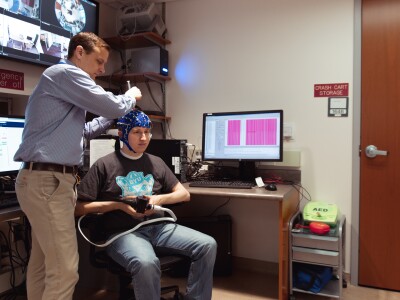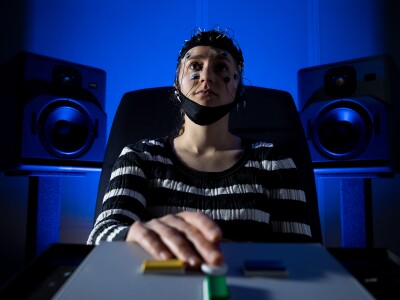Research Lab Directory
data-content-type="external"
Steven Charles
As a biomedical engineer, Dr. Charles investigates how humans control their movements, what goes wrong in movement disorders, and how to use technology to evaluate, assist, or rehabilitate patients with movement disorders. His research draws on knowledge and practices from biomechanics, neuroscience, robotics, and rehabilitation.
overrideBackgroundColorOrImage=
overrideTextColor=
promoTextAlignment=
overrideCardHideSection=
overrideCardHideByline=
overrideCardHideDescription=
overridebuttonBgColor=
overrideButtonText=
promoTextAlignment=
data-content-type="external"
Derin Cobia
Dr. Cobia's laboratory is focused on the implementation of computational anatomy tools to study neuropsychiatric diseases, particularly schizophrenia. His interests are in the clinical and biological heterogeneity that exists in schizophrenia by taking a cognitive neuroscience perspective. His work has involved linking cognitive and neurobiological characteristics to important clinical dimensions (e.g., negative symptoms) of the illness. Dr. Cobia also conducts research in a rare language-based dementia known as Primary Progressive Aphasia.
overrideBackgroundColorOrImage=
overrideTextColor=
promoTextAlignment=
overrideCardHideSection=
overrideCardHideByline=
overrideCardHideDescription=
overridebuttonBgColor=
overrideButtonText=
promoTextAlignment=
data-content-type="external"
Jeffrey Edwards
By combining electrophysiology with pharmacology, molecular biology (qPCR), optogenetics, behavioral studies, and immunohistochemistry, Dr. Edwards lab investigates synaptic plasticity—the cellular mechanism that enables our brains to learn and adapt. Our research focuses on synaptic plasticity in two key brain regions: the hippocampus, which plays a central role in learning and memory, and the ventral tegmental area, the brain's reward pathway. The ultimate goal is to understand normal brain function and apply this knowledge to abnormal conditions, such as stress, PTSD, and Alzheimer’s disease in the hippocampus, as well as the effects of drug exposure (e.g., psychedelics, morphine, THC, and polysubstance use) on the ventral tegmental area.
overrideBackgroundColorOrImage=
overrideTextColor=
promoTextAlignment=
overrideCardHideSection=
overrideCardHideByline=
overrideCardHideDescription=
overridebuttonBgColor=
overrideButtonText=
promoTextAlignment=
data-content-type=""

Shawn Gale
Dr. Gale's research mainly focuses on neurologic populations including traumatic brain injury, epilepsy, stroke, and carbon monoxide poisoning, with an emphasis on the utilization of neuroimaging techniques and their correlation with cognition.
overrideBackgroundColorOrImage=
overrideTextColor=
promoTextAlignment=
overrideCardHideSection=
overrideCardHideByline=
overrideCardHideDescription=
overridebuttonBgColor=
overrideButtonText=
promoTextAlignment=
data-content-type=""

Dawson Hedges
In his cognitive epidemiology research Dr. Hedges investigates factors that contribute to neurodegenerative diseases and neuropsychiatric outcomes with a particular focus on -the effects of chronic infection and inflammation.
overrideBackgroundColorOrImage=
overrideTextColor=
promoTextAlignment=
overrideCardHideSection=
overrideCardHideByline=
overrideCardHideDescription=
overridebuttonBgColor=
overrideButtonText=
promoTextAlignment=
data-content-type="external"
Julianne Holt-Lunstad
Dr. Holt-Lunstad's research examines the association between our social relationships and physical health and longevity, the pathways (e.g., cardiovascular, neuroendocrine, genetic, metabolic, immune, and neural) by which this association occurs, potential moderating factors, and how relationships may be applied in interventions aimed at improving health and reducing risk. Her work is interdisciplinary and takes a multilevel approach utilizing diverse methods (self-report, biological, and behavioral data) and concepts.
overrideBackgroundColorOrImage=
overrideTextColor=
promoTextAlignment=
overrideCardHideSection=
overrideCardHideByline=
overrideCardHideDescription=
overridebuttonBgColor=
overrideButtonText=
promoTextAlignment=
data-content-type="external"
Keoni Kauwe
Although he is working at BYU-Hawaii now, his faculty status at BYU-Provo has not changed and he will be continuing his research program and lab here on campus. Students who wish to know more about Dr. Kauwe's research can contact Marie Tueller Emmett. Dr. Kauwe is interested in the architecture of complex traits. His current work is focused on using genomic level data to understand the regulation of protein levels in the cerebrospinal fluid. Specifically, his lab is implementing an "endophenotype-based" approach to understanding the genetic component of risk and rate of progression of Alzheimer's disease. In this approach they first identify genetic factors that are associated with different levels of key Alzheimer's disease proteins, such as amyloid beta and tau. Those genetic factors are then tested for influences on risk or rate of progression of Alzheimer's disease. The work in Dr Kauwe's lab is focused on data analysis and bioinformatics.
overrideBackgroundColorOrImage=
overrideTextColor=
promoTextAlignment=
overrideCardHideSection=
overrideCardHideByline=
overrideCardHideDescription=
overridebuttonBgColor=
overrideButtonText=
promoTextAlignment=
data-content-type=""

Daniel Kay
Dr. Kay is interested in understanding the mechanisms and functions of sleep. He investigates sleep disturbances in relation to transdiagnostic features of psychiatric disorders across units of analysis, from genes and circuits to self-report and behavior. His sleep research laboratory is currently conducting two major projects that will help answer how sleep can be used to prevent and treat psychiatric disorders such as depression.
overrideBackgroundColorOrImage=
overrideTextColor=
promoTextAlignment=
overrideCardHideSection=
overrideCardHideByline=
overrideCardHideDescription=
overridebuttonBgColor=
overrideButtonText=
promoTextAlignment=
data-content-type="external"
Michael Larson
Dr. Larson’s research utilizes a convergence of information from neuropsychology and cognitive neuroscience methodologies to examine the mechanisms of cognitive control in healthy individuals and cognitive dysfunction following traumatic brain injury (TBI). He uses event related potentials (ERPs) and functional magnetic resonance imaging (fMRI) to show brain-based changes in how people monitor and manage their environment following head injury. He also studies how exercise influences cognitive functioning, the role of inhibitory control in food and diet behaviors, and the role of psychopathology (e.g., obsessive-compulsive disorder [OCD] and depression) in influencing cognitive control processes and concomitant brain activity.
overrideBackgroundColorOrImage=
overrideTextColor=
promoTextAlignment=
overrideCardHideSection=
overrideCardHideByline=
overrideCardHideDescription=
overridebuttonBgColor=
overrideButtonText=
promoTextAlignment=
data-content-type="external"
Steven Luke
The major focus of my research is reading, which is a complex activity that involves many different processes, most notably language and vision. I also study other aspects of language, such as language development and word and sentence comprehension, as well as other visual tasks, such as scene perception and visual search. Many different groups participate in my studies, including children and adolescents, second language learners, and individuals from various clinical populations. In my research I primarily use eye-tracking technology, although I also use MRI and EEG to study how the brain understands and integrates visual and language information during reading and other tasks.
overrideBackgroundColorOrImage=
overrideTextColor=
promoTextAlignment=
overrideCardHideSection=
overrideCardHideByline=
overrideCardHideDescription=
overridebuttonBgColor=
overrideButtonText=
promoTextAlignment=
data-content-type="external"
Rebecca Lundwall
Our research focuses on tracking developmental changes in cognitive abilities, such as attention, and investigating how these changes impact behavior, including academic success, the development of social problem-solving, and other functional skills. We have conducted studies of genetic influences on reflexive attention (attention to suddenly appearing stimuli), but are also interested in developmental changes with autism and following a concussion. We are hopeful that our research will eventually lead to more effective interventions that prevent or minimize developmental problems with cognition.
overrideBackgroundColorOrImage=
overrideTextColor=
promoTextAlignment=
overrideCardHideSection=
overrideCardHideByline=
overrideCardHideDescription=
overridebuttonBgColor=
overrideButtonText=
promoTextAlignment=
data-content-type=""

Tricia Merkley
Dr. Merkley's research focuses on neuroimage analysis and neuropsychological assessment to investigate brain changes following traumatic brain injury and how they relate to neurobehavioral functioning during recovery. These studies consider effects of TBI in both pediatric and adult populations, with the recognition that traumatic brain injury can adversely affect future brain development in childhood, in addition to impacting cognitive abilities that were previously developed.
overrideBackgroundColorOrImage=
overrideTextColor=
promoTextAlignment=
overrideCardHideSection=
overrideCardHideByline=
overrideCardHideDescription=
overridebuttonBgColor=
overrideButtonText=
promoTextAlignment=
data-content-type="external"
Jared Nielsen
In the Nielsen Brain and Behavior Lab, we are interested in answering questions about the organization of the brain and how neurological and psychiatric illnesses disrupt its organization. To answer these questions, we use a variety of analytical techniques to extract quantitative information from MRI scans.
overrideBackgroundColorOrImage=
overrideTextColor=
promoTextAlignment=
overrideCardHideSection=
overrideCardHideByline=
overrideCardHideDescription=
overridebuttonBgColor=
overrideButtonText=
promoTextAlignment=
data-content-type="external"
Ryley Parrish
The Parrish lab is addressing key questions related to epilepsy and seizure disorders. We are particularly interested in mechanisms of endogenous inhibitory restraint and spontaneous seizure termination. We also seek to understand the role of a cellular event known as a cortical spreading depression in seizure termination, a phenomenon which is also associated with migraines. Finally, the lab is working to understand the mechanisms of prolonged seizure activity, known as status epilepticus, which is often pharmacoresistant. The lab uses electrophysiology, optogenetics, live network imaging, and computer programming to address our biological questions.
overrideBackgroundColorOrImage=
overrideTextColor=
promoTextAlignment=
overrideCardHideSection=
overrideCardHideByline=
overrideCardHideDescription=
overridebuttonBgColor=
overrideButtonText=
promoTextAlignment=
data-content-type=""

Chris L. Porter
Research interests include the socialization of behavioral and psychophysiological components of young children's individual characteristics (temperament, emotionality) with particular interest on linkages to individual differences in emerging neural control on children's heart rate variability (i.e., cardiac vagal tone). Addition-al interests include familial and individual factors influencing the formation of early childhood attachment systems and familial and individual factors influencing the transition to parenting and the emergence of parenting belief systems (self-efficacy).
overrideBackgroundColorOrImage=
overrideTextColor=
promoTextAlignment=
overrideCardHideSection=
overrideCardHideByline=
overrideCardHideDescription=
overridebuttonBgColor=
overrideButtonText=
promoTextAlignment=
data-content-type="external"
Perry Ridge
Dr. Ridge’s laboratory focuses on the genetics of Alzheimer’s disease and developing computational methods/algorithms to interpret data mined from complex genomic datasets. Dr. Ridge’s current research areas include: studying the relationship of the mitochondrial genome to Alzheimer’s disease, performing family-based studies to identify rare genetic risk factors for disease, determining the functional effects of synonymous mutations in known Alzheimer’s disease genes, developing algorithms to predict the translational effects of genomic variants and to perform haplotype-based association studies. Finally, Dr. Ridge is part of the recently funded Natives Engaged in Alzheimer’s Research grant—a large collaboration of several academic institutions to build a cohort of American Indians, Alaskan Natives, Native Hawaiians, and Pacific Islanders. Dr. Ridge is co-director of the bio specimen repository and his laboratory will lead genetic analyses of the cohort.
overrideBackgroundColorOrImage=
overrideTextColor=
promoTextAlignment=
overrideCardHideSection=
overrideCardHideByline=
overrideCardHideDescription=
overridebuttonBgColor=
overrideButtonText=
promoTextAlignment=
data-content-type="external"
Michael Stark
Dr. Stark's research focuses on early nervous system development in vertebrates. He has been primarily interested in how cells make fate decisions to become a certain cell type in the nervous system. Some of his research has addressed questions related to patterning of the nervous system, neuronal cell determination, and the molecular steps leading to cellular differentiation. More recent projects in the lab have focused on CNS development and neural tube defects in the early embryo that lead to anencephaly and spina bifida.
overrideBackgroundColorOrImage=
overrideTextColor=
promoTextAlignment=
overrideCardHideSection=
overrideCardHideByline=
overrideCardHideDescription=
overridebuttonBgColor=
overrideButtonText=
promoTextAlignment=
data-content-type="external"
Sterling Sudweeks
Dr. Sudweeks studies neurotransmitter receptors that act as ion channels. These ligand-gated ion channels are involved in synaptic transmission and are implicated in several pathological conditions. They are also the pharmacological targets in many therapeutic situations. These ion channels are expressed in both the central and peripheral nervous systems. Specific receptors for the neurotransmitters gamma-aminobutyric acid (GABA), serotonin (5-HT3), glycine (GlyR), and acetylcholine (nAChRs) are all members of the ligand-gated ion channel superfamily.
overrideBackgroundColorOrImage=
overrideTextColor=
promoTextAlignment=
overrideCardHideSection=
overrideCardHideByline=
overrideCardHideDescription=
overridebuttonBgColor=
overrideButtonText=
promoTextAlignment=
data-content-type="external"
Arminda Suli
Dr. Suli's research focuses in understanding the development and formation of neurocircuits at the genetic and molecular level. There are two main projects in the lab: 1. Understanding the formation of synapses in mechanosensory hair cells, the specialized sensory cells that mediate hearing and balance in mammals and are additionally used in fish and amphibians as part of the lateral line sensory system to detect prey and predators. 2. Identification and development of neurons in the midbrain that receive and integrate inputs from multiple sensory systems, such visual, auditory and somatosensory, and which coordinate appropriate motor response to external stimuli.
overrideBackgroundColorOrImage=
overrideTextColor=
promoTextAlignment=
overrideCardHideSection=
overrideCardHideByline=
overrideCardHideDescription=
overridebuttonBgColor=
overrideButtonText=
promoTextAlignment=
data-content-type="external"
Dixon Woodbury
Dr. Woodbury's research is in molecular neuroscience and focuses on membrane biophysics, particularly vesicle/membrane fusion and its regulation by SNARE proteins. SNARE proteins form the molecular motor that drives exocytosis and are the target of tetanus and botulinum toxin. Additional research looks at effects of alcohols and cholesterol on exocytosis. More information about the Woodbury lab can be found at woodburylab. byu.edu.
overrideBackgroundColorOrImage=
overrideTextColor=
promoTextAlignment=
overrideCardHideSection=
overrideCardHideByline=
overrideCardHideDescription=
overridebuttonBgColor=
overrideButtonText=
promoTextAlignment=
data-content-type="external"
Jordan Yorgason
Jordan Yorgason and colleagues are interested in the neurobiology of motivation for natural and drug rewards. The laboratory uses electrophysiology, electrochemistry, functional microscopy and behavioral techniques to study the effects of opiates on anxiety related brain circuitry. We are also interested in how psychostimulants affect midbrain dopamine circuitry, and how dopamine underlies learned associations for drug-seeking behavior. We are continually developing new techniques to study the pathology of addiction.
overrideBackgroundColorOrImage=
overrideTextColor=
promoTextAlignment=
overrideCardHideSection=
overrideCardHideByline=
overrideCardHideDescription=
overridebuttonBgColor=
overrideButtonText=
promoTextAlignment=
overrideBackgroundColorOrImage=
overrideTextColor=
promoTextAlignment=
overrideCardHideSection=
overrideCardHideByline=
overrideCardHideDescription=
overridebuttonBgColor=
overrideButtonText=















